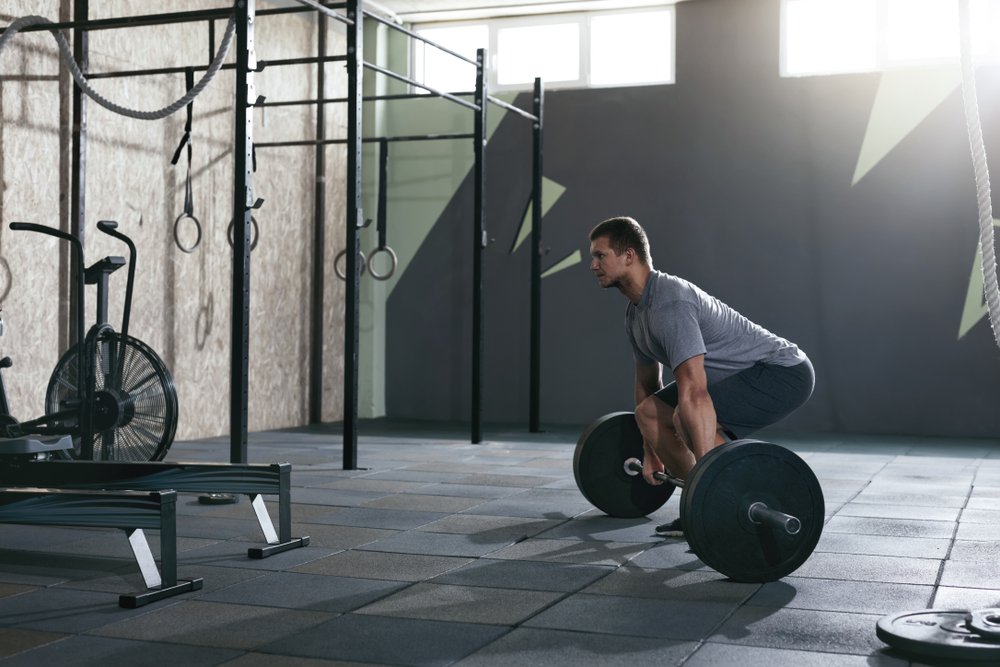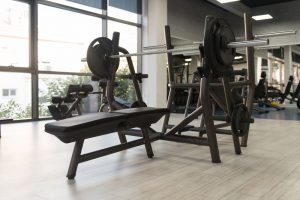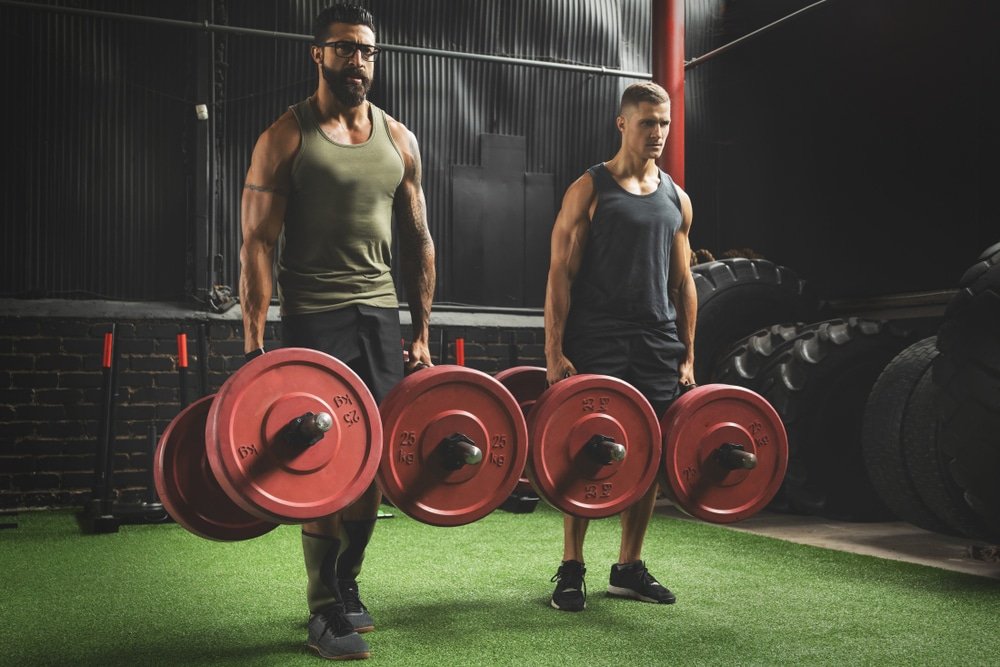The rack pull is one of the most underrated exercises that you can perform in the gym, with huge benefits for grip strength, trap strength, and deadlift ability. In this article, we will look at how to do a rack pull correctly.
How to Do a Rack Pull
To perform a rack pull you will need either a weightlifting power rack or a Smith machine (though the power rack is infinitely preferrable). It is also possible to stack bumper plates on top of each other and place a barbell on top, but this method is a lot less stable, and uses up a lot of bumper plates! You may not be too popular in your gym.
- You want to set the rack height to suit your needs, either just below the knee or above it. Don’t have the bar at knee height exactly though, as your knees will get in the way and you won’t be able to perform the lift satisfactorily.
- The way to decide which height to use is to perform regular deadlifts and identify at what point you struggle. If it is while the bar is below the knee, then that’s where you set the height for your rack pull. If above, then set the height to above.
- Once the barbell is in place, walk up the bar as if you were about to perform a regular deadlift. Have your feet at the right distance (imagine you are about to jump in the air, look at the width of your feet, that is your deadlift stance).
- If the bar is below knee height then place your knees over the bar until your upper shins are touching, if the bar is above knee height then place your knees under the bar so that it is resting on your thighs.
- Grab the bar using an overhand grip (or mixed if that is how you usually deadlift) so that your hands are just outside of your knees. Push your chest out and pull your shoulders together. Take a deep breath and brace your abs.
- Raise the bar up, pushing your hips forward and breathing out as you do so. Pause at the top, and then slowly lower the barbell back down to the rack. Place the barbell carefully on the rack (don’t bounce it), reset, and the restart the movement for a second rep.
 Rack Pull Form & Technique Tips
Rack Pull Form & Technique Tips
There are several ways that you can improve your rack pull form and technique. This will allow you to excel and will carry over into your regular deadlifts.
- Focus on Grip – Rack pulls are designed to allow you to lift more weight than you can during a regular deadlift. This is due to the reduced range of motion (ROM). But the exercise still requires your grip to be up to the challenge. Use chalk or weightlifting straps to improve grip. You can also perform exercises such as farmer’s walks, shrugs, and hammer curls to strengthen your grip and forearms. Rack pulls themselves are excellent for improving your grip.
- Control the Weight – Because of the shortened range of motion and the heavier load, rack pulls are often seen as an excuse to bang the weight down on the rack and use the momentum of the barbell to “bounce” back up. This looks pretty awesome but won’t help you with your deadlifts. Control the weight throughout, particularly during the eccentric part of the lift. Lower the weight if you have to.
- Breathe Better – Improving how you breathe during a rack pull or deadlift can make a huge difference to your success. Take a deep breath before lifting, and tighten (brace) your abs. This creates a block which can not only help protect your back, but will help you lift more.
- Respect the Rack – Rack pulls are often added into programs as a way of fixing a deadlift that is underperforming. But they are excellent exercises in their own right. Performing rack pulls every couple of weeks is a good habit to get into. The benefits to your deadlift will soon be obvious.
Benefits of a Rack Pull
There are lots of benefits to performing rack pulls, though most of them are general exercise and fitness benefits. Here are a couple of benefits that are specific to the movement.
- Grip Strength – Other than perhaps shrugs and farmer’s walks, there is no better exercise for improving your grip strength. The shortened ROM allows you to deadlift heavier weights than you are used to, and this all starts with your grip.
- Blast Through Sticking Points – The rack pull was designed to help you improve your deadlift. Helping identify weaknesses in your lift, and to strengthen them specifically. It can also help you to improve your technique.
- Build Better Glutes – Thanks to the limited ROM of a rack pull, your glutes are targeted quite heavily. This is a great exercise for building bigger, stronger glutes.
 Muscles Worked During a Rack Pull
Muscles Worked During a Rack Pull
Here are a list of the muscles worked during a rack pull:
- Trapezius
- Lats
- Muscles of the forearms
- Erector Spinae and other muscles of the spine
- Glutes
- Hamstrings
- Quadriceps
- Abdominals
Rack Pull Variations
There are a couple of rack pull variations available, but the regular version should suit most people’s needs.
- Band-Assisted Rack Pull – Also known as a reverse-rack pull. This variation focuses instead on the top of the lift rather than the initial part. Attach one band to each side of the top of the rack and loop them onto the barbell. They should be tight when the barbell is on the rack. Use a weight that is heavier than you would usually use for a rack pull. It will start off with a lot of assistance, but as the bar rises up the assistance will decrease. Forcing you to work harder.
- Snatch Grip Rack Pull – This is exactly the same as a regular rack pull but using a much wider grip. This will help with snatch grip deadlifts and also for the Olympic Snatch.
 Rack Pull Alternatives
Rack Pull Alternatives
The truth is, that there aren’t really any useful alternatives to the rack pull. The rack pull itself is an alternative to the deadlift. If you are looking for an alternative exercise for working the hamstrings, glutes, and lower back, then Good Mornings, Romanian deadlifts, and regular deadlifts are a good choice.
If you are looking for a good alternative for grip strength then shrugs, farmer’s walks, hammer curls, and most pulling exercises are okay.
Frequently Asked Questions
Here are some common questions that are often asked in relation to rack pulls. Most have been addressed in the article, but it makes sense to highlight them here as well.
Are Heavy Rack Pulls Dangerous?
Any exercise that is performed incorrectly is dangerous, compared to a bench press where you can get stuck under the bar then a heavy rack pull is fairly safe. Always focus on your form, worry about the weight after that.
Are Rack Pulls a Compound Movement?
Absolutely, they work several muscle groups simultaneously. Glutes, quads, hamstrings, upper back, lower back, abdominals.
Should I do Rack Pulls Above or Below the Knee?
Either? Both? Look at your deadlift technique when you fail a lift. If below the knee then that’s where you do rack pulls.
Are Rack Pulls Bad for My Lower Back?
Badly performed rack pulls will damage your lower back. Expertly performed rack pulls will strengthen and benefit your lower back.



 Rack Pull Form & Technique Tips
Rack Pull Form & Technique Tips Muscles Worked During a Rack Pull
Muscles Worked During a Rack Pull Rack Pull Alternatives
Rack Pull Alternatives



No Comments yet!